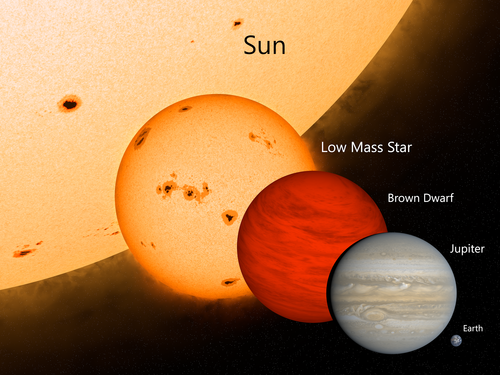Red dwarf (star)
Red dwarf is a designation that can be given to some stars less massive and dimmer than the sun. According to the Hertzsprung-Russell diagram, a red dwarf star is a small and relatively cool star, of the main sequence, either late K or M spectral type. They constitute the vast majority of stars and have a mass of less than one-half that of the sun (down to about 0.075 solar masses, which are brown dwarfs) and a surface temperature of less than 3,500 K.
Description and characteristics
Red dwarfs fuse hydrogen to helium via the proton-proton (PP) chain. Due to the low temperatures in the core, fusion proceeds slowly. Consequently they emit little light, sometimes as little as 1/10,000th that of the sun.
In general, red dwarfs transport energy from the core to the surface via convection. As red dwarfs are fully convective, they can burn a larger proportion of their hydrogen before leaving the main sequence than larger stars, such as our sun. Red dwarfs have an enormous estimated lifespan, from tens of billions up to trillions of years, depending upon mass; the lower the mass, the longer the lifespan.
The fact that red dwarfs and other low mass stars remain on the main sequence while more massive stars have moved off the main sequence allows one to date star clusters, by finding the mass at which the stars turn off the main sequence. This provides a lower, stellar, age limit to the Universe and also allows formation timescales to be placed upon the structures within the Milky Way galaxy, namely the galactic halo and galactic disk.
One mystery which has not been solved as of 2007 is the lack of red dwarf stars with no metals (in astronomy, a metal is any element other than hydrogen and helium). The Big Bang model predicts the first generation of stars should have only hydrogen, helium and lithium. If such stars included red dwarfs, they should still be observable today, but as yet none have been identified. One explanation is that without heavy elements, low mass stars cannot form. Alternatively, as they are dim and could be few in number, they are yet to be observed.
Red dwarfs are the most common star type in the galaxy, at least in the neighbourhood of the sun. Proxima Centauri, the nearest star to the sun, is a red dwarf (Type M5, apparent magnitude 11.05), as are twenty of the next thirty. However, due to their low luminosity, individual red dwarfs cannot be easily observed over the vast intergalactic distances that luminous stars can.
Planets
Extrasolar planets were discovered orbiting red dwarfs in 2005, one as small as Neptune, or seventeen earth masses. It orbits just 6 million kilometres (0.04 AU) from its star, and so is estimated to have a surface temperature of 150 °C, despite its dimness. In 2006, an even smaller extrasolar planet (only 5.5 times the mass of Earth) was found orbiting a red dwarf; it lies 390 million km (2.6 AU) from the star and its surface temperature is estimated to be -220 °C (56 K).
In 2007, a team led by Stephane Udry) found a potentially habitable extrasolar planet, Gliese 581 c, orbiting the red dwarf star Gliese 581.[1] If the team's estimate of the planet's mass at 5.03 times that of Earth is correct, it is the smallest extrasolar planet revolving around a normal star discovered to date.[2] The team estimate its radius to be 1.5 times that of the Earth. This planet is within the habitable zone of Gliese 581, and is the most likely candidate for habitability of any extrasolar planet discovered so far.
Habitability
Planetary habitability of red dwarf star systems is subject to some debate. In spite of their great numbers and long lifespans, there are several factors which may make life difficult on planets around a red dwarf star. First, planets in the habitable zone of a red dwarf would be so close to the parent star that they likely would be tidally locked. This would mean that one side would be in perpetual daylight and the other in eternal night. This could create enormous temperature variations from one side of the planet to the other, making it difficult for life to evolve. On the other hand, recent theories propose that either a thick atmosphere or planetary ocean could potentially circulate heat around the planet. Another potential problem is that red dwarfs emit most of their radiation as infrared light, while on Earth plants use energy mostly in the visible spectrum.
Perhaps the most serious problem may be stellar variability. Red dwarfs are often covered in starspots, reducing stellar output by as much as 40% for months at a time. At other times, some red dwarfs, called flare stars, can emit gigantic flares, doubling their brightness in minutes. This variability may also make it difficult for life as we know it to survive near a red dwarf star.
Footnotes
- ↑ BBC News: 'New 'super-Earth' found in space.' 25th April 2007. Soon after, a reader of New Scientist magazine wrote in to inquire where the BBC thought a 'super-Earth' could otherwise be found.
- ↑ There are smaller planets known around a neutron star, named PSR B1257+12.
